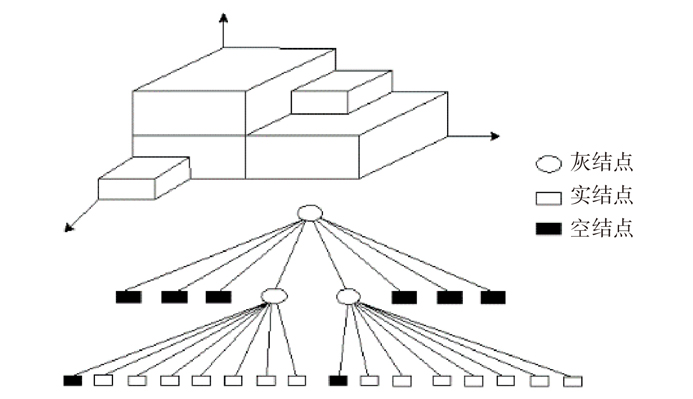光电工程, 2023, 50 (2): 220240, 网络出版: 2023-04-13
基于激光雷达数据的火星表面障碍物识别
Obstacle recognition on Mars surface based on LiDAR data
摘要
火星车的环境感知能力是其进行智能移动和探测的基础,而障碍物检测识别是环境感知中的一个重要方面,识别效果直接决定了火星车工作能力和安全性。本文提出一种基于激光雷达数据的火星表面障碍物自动识别方法。通过获取的激光雷达点云数据,首先在分析激光反射强度理论的基础上,通过强度补偿理论将点云强度根据距离、角度因素进行修正,进而构建激光雷达强度值与目标特征的反射关系。通过大津法自动求取全局阈值,自适应的将火星表面点云分类为障碍物点云和非障碍物点云;然后通过曲率约束剔除不符合条件的障碍物点云;最后利用基于八叉树叶节点的连通性聚类,实现火星表面障碍物点云的识别。模拟实验结果表明,该方法可实现激光雷达点云中的火星表面障碍物有效提取,典型障碍物识别精度接近90%,为基于火星车障碍物检测和环境感知相关研究提供借鉴。
Abstract
Overview: The environment perception ability of the rover is the basis of its intelligent movement and detection, and obstacle detection and recognition is an important aspect of the environment perception, and the recognition effect directly determines the work ability and safety of the rover. At present, the obstacle recognition of Mars exploration vehicles mainly relies on binocular cameras. This passive measurement method based on vision is easy to fail in 3D reconstruction in weak texture and low brightness areas. As a direct measurement method, lidar has better performance in the face of the above disadvantage scenarios, so it has attracted more attention in the current hot field of automatic driving. This paper proposes an automatic obstacle recognition method for the Mars surface based on lidar data. Firstly, based on the analysis of the laser reflection intensity theory, the point cloud intensity was corrected according to the distance and angle factors through the intensity compensation theory, so as to eliminate the intensity difference of homogeneous ground objects caused by the difference in distances and angles, and then the reflection relationship between the laser radar intensity value and the target feature was accurately constructed. The global threshold was automatically obtained by the Otsu method, and the point cloud on the Mars surface was adaptively classified into an obstacle point cloud and a non-obstacle point cloud. Then, the curvature threshold is set, the unqualified obstacle point cloud is eliminated by curvature constraint, and the obtained point cloud belongs to the obstacle. Finally, the connectivity clustering based on octree leaf nodes is used to segment the obstacle point cloud into independent individuals. On this basis, the typical obstacles larger than a specific size are separated from the obstacle point cloud by setting the obstacle diameter size threshold, so as to realize the automatic recognition of the Martian surface obstacle point cloud. The size of the simulated Martian surface field tested in this paper is 22 m×16 m, and the main obstacles in the scene are rocks and other vehicle detectors. The experimental data collection and processing of the simulated field show that the proposed method can effectively extract the Martian surface obstacles in the lidar point cloud, and the recognition accuracy of typical obstacles is close to 90%, which can provide a reference for the related research based on the Martian rover obstacle detection and environmental perception. Of course, the current popular deep learning method is also a highly intelligent recognition method, so the obstacle point cloud recognition based on deep learning is also a kind of idea worthy of subsequent discussion and experiment.The environment perception ability of the Mars rover is the basis of its intelligent movement and detection. Obstacle detection is an important aspect of environment perception, which directly determines the working ability and safety of the Mars rover. In this paper, a method of identifying obstacles on the surface of Mars based on LiDAR data is proposed. Based on the obtained LiDAR point cloud data, the intensity of the point cloud is modified according to the distance and angle factors through the intensity compensation theory based on the analysis of the laser reflection intensity theory, and then the reflection relationship between the lidar intensity value and the target characteristics is constructed. The global threshold is automatically obtained through the Otsu method, and the Mars surface point cloud is adaptively classified into an obstacle point cloud and a non-obstacle point cloud. Then, the obstacle point cloud which does not meet the conditions is removed by curvature constraint. Finally, using the connectivity clustering based on Octree-based leaf nodes, the recognition of the obstacle point cloud on the surface of Mars is realized. Through the simulation experiment, the results show that this method can effectively extract the obstacles on the surface of Mars from the LiDAR point cloud, and provide a reference for the related research based on the obstacle monitoring of the Mars rover and environmental perception.
陈海平, 李萌阳, 曹庭分, 严寒, 张亮, 张尽力, 王成程. 基于激光雷达数据的火星表面障碍物识别[J]. 光电工程, 2023, 50(2): 220240. Haiping Chen, Mengyang Li, Tingfen Cao, Han Yan, Liang Zhang, Jinli Zhang, Chengcheng Wang. Obstacle recognition on Mars surface based on LiDAR data[J]. Opto-Electronic Engineering, 2023, 50(2): 220240.




